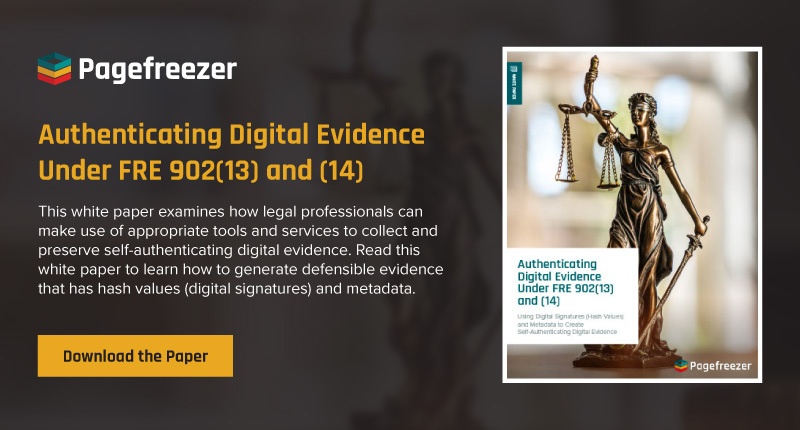With the digital realm increasingly shaping both our personal and professional lives, the rise of electronic evidence in legal cases was inevitable. But as technology advances, so do the methods for creating fake digital evidence, posing significant challenges for courts.
In the 2020s, we've seen a rapid uptick in the use of digital communication in professional settings, especially through collaboration platforms like Microsoft Teams.
An increase in any kind of interaction, especially in a non face-to-face environment where parties are obscured through digital platforms, will unfortunately lead to more misunderstandings, conflicts and challenges. As such, there has been an increasing need to collect and present digital evidence in court.
Unfortunately, there are countless ways to manipulate, misrepresent, edit, fake, or photoshop digital evidence, leaving plenty of room for deception when this evidence is presented in court.
So, what happens when fake electronic evidence is used in court?
In this article, we’ll explore the challenges courts are encountering when it comes to falsification of digital evidence or testimonies, review a case where digital evidence was forged through various digital means, and discuss a few preventative and protective measures.
The Rise of Electronic Evidence in Court
Courts represent some of the most well-established and historic establishments in any community.
In reality, courts are evolving as a matter of necessity to keep pace with the rapidly changing digital landscape, as well as their own intersections with technology. And of course to keep up with the higher volumes of digital evidence being presented in court and contending with increasingly sophisticated methods of falsification, creating fake digital evidence.
Courts have also had to cope with the huge pivot that the 2020 global pandemic necessitated in terms of virtual hearings. Without being able to examine cases in person, video conferencing provided an alternative that enabled justice to continue to be served, but it was not without its challenges. In particular, the coaching of witnesses provided considerable cause for concern.
Lenihan v. Shankar: A Case Study In Digital Deception
Let’s explore an instance where fake electronic evidence and digital deception were leveraged with the intention of misleading a court.
The case of Lenihan v. Shankar saw a considerable amount of electronic forgery and fraud. This custody litigation was the result of a dispute between a father based in the United States and a mother who relocated to Canada while pregnant. The mother obtained permanent-residency status in Canada and was proactively taking measures to keep her daughter from being seen by her American father.
When the case came to trial, the mother was found to have falsified a paternity test, forged a sperm donor agreement, and created fake email exchanges, which she claimed were the result of exchanges made between her and the father. The issue was so clear-cut that upon realizing their unwitting participation in presenting false evidence to the court, her trial counsel immediately called to have it withdrawn from the record.
After absconding to India, the mother continued to participate in the legal proceedings via Zoom. She called a witness on Zoom, but it soon became clear to the judge, Justice McGee, that they were bogus, and as a result, they were swiftly disqualified. The witness in question claimed to be the girl’s biological father, but “had the appearance of a student” and raised suspicions when he appeared to read answers to prepared questions. Another witness admitted that she had never had dealings or interaction with the mother and that the statement submitted on her behalf was entirely false, complete with a forged signature.
What’s notable here is the wide range of digital sources from which this fake digital evidence was generated—from email to SMS, co-parenting apps, social media, and video calling.
Key Learnings
This case highlights the importance of saving all electronic communications and other documents in a reliable electronic format. Digital evidence is easily tampered with, and having a defensible record of all online communications does more than provide the owner with a solid source of evidence. It also means that, should fake electronic evidence be submitted in an attempt to pervert the outcome of the case in question, a reliable counter can be made and backed up.
Unfortunately, relying on simple screenshots of conversations or evidence won't be enough to guarantee authenticity and will be scrutinized in court -- as they should be.
Legal teams should always look into the authenticity of everything they're presented with. Hash values and metadata are crucial in making sure that digital evidence is authentic. Additionally, in order for digital evidence to be credible when presented in court, the manner and method of its collection are of paramount importance. Ultimately, there’s a need to show how documents have been captured, preserved, and presented, showing a clear chain of custody.
The Challenges of Fake Electronic Evidence
The Rise of AI and Sophisticated Manipulation Technology
As digital technologies and communication platforms become more sophisticated and integrated with AI, the need for absolute control over the recording and capture of electronic evidence will become essential in proving its authenticity.
Deep fakes are a great example of the havoc these new, readily accessible and easy to operate technologies will have on courts trying to discern between genuine and very convincing fake evidence.
Thankfully, the techniques used to discover and disprove fake digital evidence are also improving. For example, investigators, courts and legal teams are relying more on metadata to help to add vital additional context to collected evidence, such as timestamps, device info, IP addresses, or location details.
For example, metadata linked to German Green Party politician Malte Spitz's telephone use was used to confirm his every move.
The Ephemerality of Online Evidence
Digital evidence on the web or on digital communication platforms can be lost quickly if posts are edited or deleted.
As a result, there’s a temptation to capture evidence quickly, using screenshots, but this method of capture is frequently attacked as being too easy to tamper with. Managing chain of custody of screenshots is incredibly cumbersome and time consuming, as is attempting to capture all the evidence in a long thread or conversation with simple screenshots. They also lack sufficient metadata to prove their authenticity and important context that is necessary to interpret the evidence.
Fake Online Evidence: Be Prepared
When it comes to presenting digital evidence in court, preparation is key.
The first step is to make sure your evidence capture methods are sound and efficient. Using an automated web preservation tool that can quickly capture everything before it disappears, including all context and metadata is just the first step. Whatever capture method you use should also provide digital signatures and hash values that prove the authenticity of the evidence.
If you're working in eDiscovery or on an in-house legal team attempting to capture evidence from internal communication channels like Microsoft Teams, automated archiving is the best way to ensure all the evidence is fully secure, searchable, with all necessary metadata and timestamps included.
As technology designed to forge and fake becomes ever more advanced, the need to counter this deception will grows. By ensuring that a clear chain of custody is maintained at all times with any collected evidence, you can not only help to support your own case but also be ready with a defence if false allegations are made.
To help legal teams understand what's needed to authenticate digital evidence under FRE 902(13) and (14), we created a comprehensive resource that condenses hundreds of pages of official guidelines. Click the button below to download the resource.








